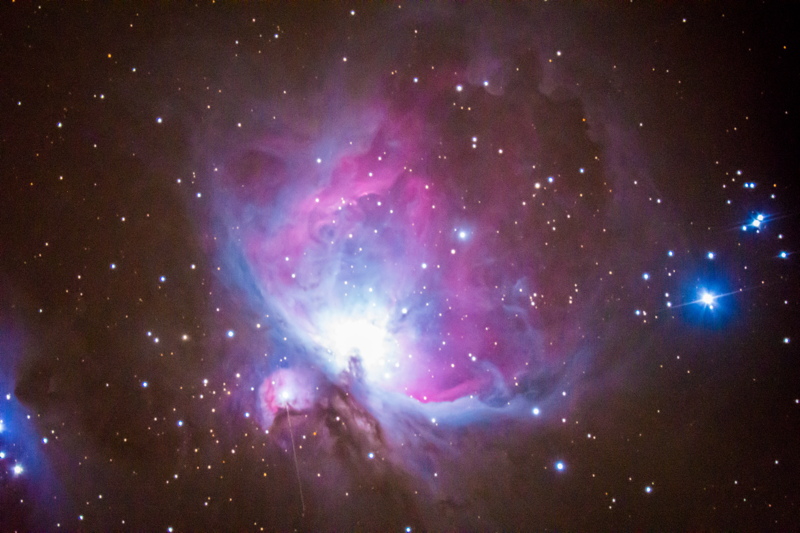Belt of Venus;
Imaging: V1025 Tauri, Crab, Flame, Horsehead, Orion Nebulae
Posted: 2 January 2016
The first day of the New Year dawned clear. The "Belt of Venus" and the Earth's shadow were very distinct in the western sky at sunrise:

Mouseover or tap on photo for labels
The shadow of Mt Lemmon is visible (rollover/tap the photo to see labels).
|
Open: Friday, 1 January 2016, 1810 MST Temperature: 54°F |
Session: 903 Conditions: Mostly clear, breezy |
1816 MST: first viewed Mercury, low in the southwest, 83X. View not good due to the planet's low altitude in sky.
Then slewed to the star Aldebaran and began preparations for the night's Deep Sky Object (DSO) imaging with the Nikon D7200 DSLR. Added the Antares Focal Reducer to the Meade 8" LX200-ACF along with an extension and off-axis guider (OAG). Synced the AutoStar on Aldebaran and did a focus test image using the Spike-a Bahtinov Mask. 1902 MST: saw a nice meteor in the constellation of Orion. Powered on the GC Wi-Fi Adapter and used SkySafari 5 Pro to GOTO to V1025 Tauri (which I had previously saved in the Observing List). Ever since I heard Adam Block from the Mt Lemmon SkyCenter show his image of V1025 Tauri taken with a 32" telescope on Mt Lemmon, I was curious whether I could capture it. I certainly did not expect to be able to get the details in Adam's image but would be happy to get some nebulosity. After locating a faint guide star, I did get some nebulosity in my image, seen at the center of this guided 10 minute, ISO 12800, exposure (cropped from the full-frame image and converted to Black-and-White):

I then slewed to M1 (Crab Nebula), found a faint guide star, and took this B&W (cropped) image, guided 5 minute, ISO 12800:

Next, used SkySafari 5 Pro to GOTO IC434 (Horsehead Nebula). 2015 MST: wind speed had picked up. I did some framing test exposures to get the Flame Nebula and the Horsehead Nebula in the same field-of-view. Once I was happy with the framing I tried to locate a good guide star but didn't find one. So I did a series of 1 minute, ISO 12800, exposures, unguided. This is one image, 1 minute, ISO 12800:

I stacked 11 of the exposures using Lynkeos, resulting in this image (effective exposure length of 11 minutes) of the Flame and Horsehead nebulae:

The bright overexposed star is Alnitak, the left-most star in Orion's belt.
2049 MST: I decided to defer my planned imaging of other faint DSOs to a future session due to the wind and a neighbor's bright outdoor Holiday Lights that might impact on long exposures. But I did decide to grab a quick image of M42 (the Great Nebula in Orion). This is an unguided 1 minute, ISO 12800, exposure:

Click or tap on image for larger version
A faint satellite passed a short distance through the image during the short exposure.
2058 MST: removed the camera, OAG, and extension from the telescope, and viewed M42 at a magnification of 53X. Lovely wide-angle view. Then removed the focal reducer and viewed M42 at 83X.
2112 MST: as I was beginning to close up due to the wind, saw a nice meteor pass through the constellation of Canis Major.
Overall, this was a wonderful night to begin the New Year at Cassiopeia Observatory.
|
Close: Friday, 1 January 2016, 2118 MST Temperature: 46°F |
Session Length: 3h 08m Conditions: Clear, windy |
Comments are welcome using Email. If you are on Twitter you can use the button below to tweet this report to your followers. Thanks.
Cassiopeia Observatory Home Page
Copyright ©2016 Michael L. Weasner / mweasner@me.com
URL = http://www.weasner.com/co/Reports/2016/01/02/index.html
